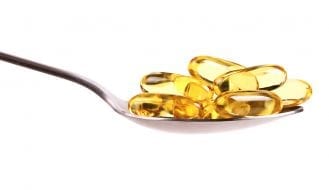How Fish Oil Can Benefits Our Pets’ Health
Every morning Bo and I enjoy watching our 11-year-old, four-legged sweetheart fiercely defend his turf, leaping after the chipmunks that scamper in the trees over his head. Thor, part Australian Shepherd and part Husky, has slowed down a bit, but still moves like a two-year-old when it comes to hunting chipmunks and rabbits. We like to think it’s due to his daily dose of Omega Cure®.
Since I want Thor to be able to do his high-jumping tricks for as long as possible, we supplement his food with Omega Cure – our high-quality, fresh fish oil.
Here at Omega3 Innovations, we jokingly tell customers that Omega Cure is like WD-40® for a person’s aching joints. But it’s not just people who benefit from omega-3s. Animals can experience the pain-relieving effects too.
We’ve seen the health benefits for animals with our Wellpride Company, which creates omega-3 fish oil for horses. After supplementing their horse’s feed with the Wellpride omega-3 oil, most horse owners report that their horse’s stride increases – a sign of improved joint flexibility.
Although supplementing pet feed with omega-3s may seem unconventional, small animal veterinarians have been prescribing omega-3 fish oil for skin and joint conditions in dogs and cats for the last 20 to 30 years.
So how much should your four-legged baby be taking? Small animal Veterinarian and Neurologist, Anne Chauvet, recommends:
For a small dog or cat (less than 10 lb), use ½ teaspoon Omega Cure every day.
For larger dogs, use 1-2 teaspoons daily.
Expect to see mood improvements within four to five weeks and a shining, healthy coat and less skin irritation in six to eight weeks. Joint improvements may take a few weeks longer.
Three studies conclude what Omega3 Innovation’s customers have already experienced when they give Omega Cure to their limping, arthritic-ridden pets. Omega-3 fish oil doesn’t take away the osteoarthritis, but it does enable them to move more comfortably:
1. One study on dogs with osteoarthritis found that dogs eating a diet containing high levels of omega-3s from fish had improved ability to move.
2. In 2010, another study assessed the effect of food containing high concentrations of fish oil and a low omega-6 to omega-3 fatty acid ratio on osteoarthritic dogs. The conclusion showed raising the blood concentrations of omega-3 fatty acids improved the arthritic condition in the dogs.
3. At the College of Veterinary Medicine, Kansas State University, 38 client-owned dogs with osteoarthritis were fed a typical commercial food or a test food containing 3.5 percent fish oil for three months. The dogs fed the test food had significant improvements in lameness and weight bearing compared to those eating regular dog food.
Your beloved four-legged baby deserves a healthy, joint-pain free life. So add a few golden drops to your pet’s daily diet.
Popular posts



Related posts






